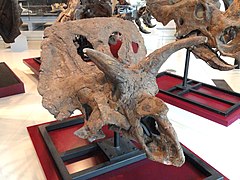| Arrhinoceratops Temporal range: Early Maastrichtian,
| |
|---|---|

| |
| Arrhinoceratops brachyops at the Royal Ontario Museum | |
| Scientific classification | |
| Domain: | Eukaryota |
| Kingdom: | Animalia |
| Phylum: | Chordata |
| Clade: | Dinosauria |
| Clade: | †Ornithischia |
| Clade: | †Neornithischia |
| Clade: | †Ceratopsia |
| Family: | †Ceratopsidae |
| Subfamily: | †Chasmosaurinae |
| Genus: | †Arrhinoceratops Parks, 1925 |
| Species: | †A. brachyops
|
| Binomial name | |
| †Arrhinoceratops brachyops Parks, 1925
| |
Arrhinoceratops (meaning "no nose-horn face", derived from the Ancient Greek "a-/α-" "no", rhis/ῥίς "nose" "keras/κέρας" "horn", "-ops/ὤψ" "face") is a genus of herbivorous ceratopsian dinosaur. The name was coined as its original describer concluded it was special because the nose-horn was not a separate bone, however further analysis revealed this was based on a misunderstanding.[1] It lived during the latest Campanian/earliest Maastrichtian stage of the Late Cretaceous, predating its famous relative Triceratops by a few million years, although it was contemporary with Anchiceratops.[1] Its remains have been found in Canada.[1]